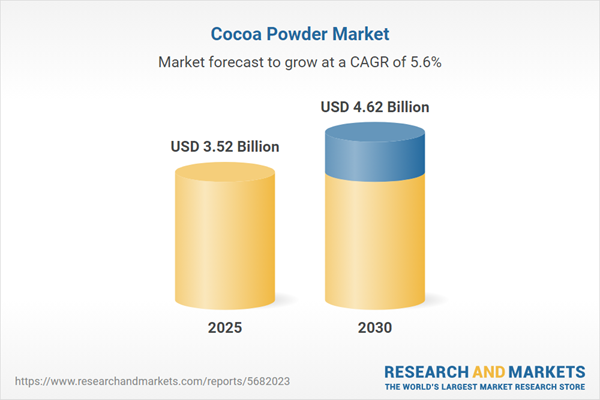The global cocoa powder market is experiencing continuous growth due to the rising popularity of chocolate and cocoa products, increasing consumer awareness of the health benefits, diversification of cocoa products, and technological advancements in cocoa processing and formulation.
Market Drivers
- Growing Demand for Chocolate Products: The increasing global consumption of chocolate and cocoa-based items is a significant driver, with brands seeking high-quality cocoa powder to enhance flavor and texture in artisanal chocolates, premium chocolate bars, and cocoa-infused desserts.
- Rising Health and Wellness Trends: Consumers are increasingly conscious of the health benefits of cocoa powder, such as its antioxidant properties, leading to a rise in demand for organic, prebiotic, and functional cocoa powders.
- Increasing Demand for Cocoa-Based Beverages: The popularity of cocoa-based beverages like hot chocolate, energy drinks, and protein shakes is rising as consumers seek healthier drink options.
- Diversification of Applications: The cocoa market is expanding beyond traditional confectionery uses into cosmetics, pharmaceuticals, and beverages, broadening its reach and creating new opportunities.
- Growing Consumption of Bakery Products: The rising consumption of bakery products is increasing the demand for cocoa powder.
- Innovation in Product Development: The production of new and diverse cocoa powder products, such as flavored cocoa powders and cocoa powders containing protein, is increasing.
Regional Outlook
- North America: North America is forecasted to hold a major market share due to robust confectionery and bakery industries, a growing trend towards natural and organic ingredients, innovative products for the chocolate-based food industry, and increasing consumer awareness of the healthy properties of cocoa.
- Asia-Pacific: The Asia-Pacific region exhibits the highest growth rate, driven by rising disposable incomes and Western food trends in countries like China and India
Reasons for buying this report::
- Insightful Analysis: Gain detailed market insights covering major as well as emerging geographical regions, focusing on customer segments, government policies and socio-economic factors, consumer preferences, industry verticals, other sub- segments.
- Competitive Landscape: Understand the strategic maneuvers employed by key players globally to understand possible market penetration with the correct strategy.
- Market Drivers & Future Trends: Explore the dynamic factors and pivotal market trends and how they will shape up future market developments.
- Actionable Recommendations: Utilize the insights to exercise strategic decision to uncover new business streams and revenues in a dynamic environment.
- Caters to a Wide Audience: Beneficial and cost-effective for startups, research institutions, consultants, SMEs, and large enterprises.
What can businesses use this report for?
Industry and Market Insights, Opportunity Assessment, Product Demand Forecasting, Market Entry Strategy, Geographical Expansion, Capital Investment Decisions, Regulatory Framework & Implications, New Product Development, Competitive Intelligence.Report Coverage:
- Historical data & forecasts from 2022 to 2030
- Growth Opportunities, Challenges, Supply Chain Outlook, Regulatory Framework, Customer Behaviour, and Trend Analysis
- Competitive Positioning, Strategies, and Market Share Analysis
- Revenue Growth and Forecast Assessment of segments and regions including countries
- Company Profiling (Strategies, Products, Financial Information, and Key Developments among others)
Cocoa Powder Market is analyzed into the following segments:
By Type
- Natural Cocoa Powder
- Dutch-process Cocoa Powder
By Application
- Confectionery
- Bakery
- Beverages
- Cosmetics
- Others
By Distribution Channel
- Online
- Offline
- Hypermarket/Supermarket
- Convenience and Specialty Stores
- Others
By Geography
- North America
- United States
- Canada
- Mexico
- South America
- Brazil
- Argentina
- Others
- Europe
- United Kingdom
- Germany
- France
- Spain
- Others
- Middle East and Africa
- Saudi Arabia
- UAE
- Israel
- Others
- Asia Pacific
- Japan
- China
- India
- South Korea
- Indonesia
- Thailand
- Others
Table of Contents
Companies Mentioned
- Cargill, Incorporated
- Barry Callebaut
- The Hershey Company
- Dutch Cocoa
- Olam International
- KANY Corporation
- Indcre S.A.
- Blommer
- Mondelez International Inc.
Table Information
| Report Attribute | Details |
|---|---|
| No. of Pages | 152 |
| Published | January 2025 |
| Forecast Period | 2025 - 2030 |
| Estimated Market Value ( USD | $ 3.52 Billion |
| Forecasted Market Value ( USD | $ 4.62 Billion |
| Compound Annual Growth Rate | 5.5% |
| Regions Covered | Global |
| No. of Companies Mentioned | 9 |









